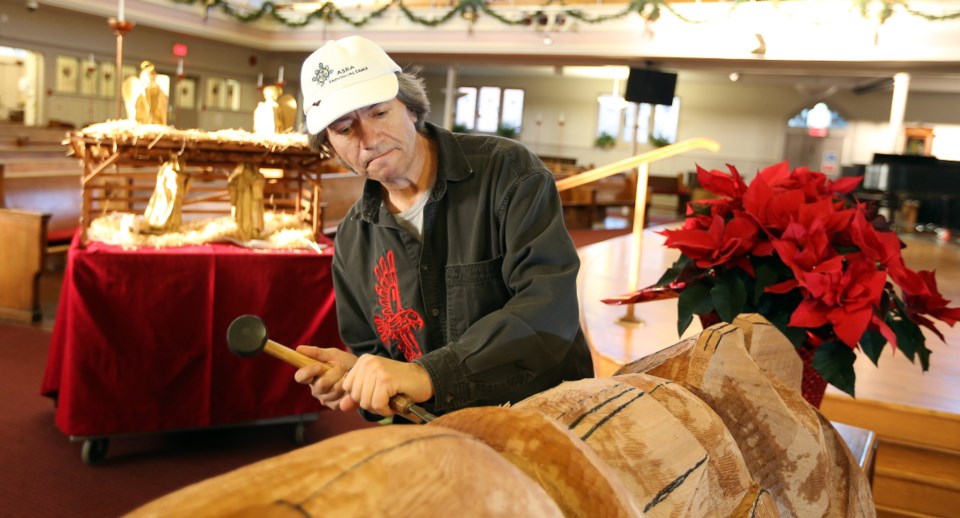KwaGulth artist and dancer Tony Hunt Jr., part of a long line of First Nations carvers on Vancouver Island, has died. He was 55.
Stan Hunt was with his nephew at Royal Jubilee Hospital on Thursday, the day he died. He did not want to disclose details of his nephew’s medical conditions or have it detract from his nephew’s memory, saying only that he had been very sick for months and couldn’t be helped.
“I was with him since Sunday and I only told him positive things until the night before and still, honestly, we thought things would work out differently than this.”
He had a high regard for his nephew, just eight years his junior.
“He was a brilliant, talented, humble young man and loved by his family,” Stan Hunt said. “He made a huge contribution to the art world.”
Tony Hunt Jr. was born Dec. 4, 1961, part of a renowned family of carvers and artists that includes his grandfather Henry Hunt and his great-grandfather Mungo Martin. His father, Tony Hunt Sr., hereditary chief of the Kwakwaka’wakw (KwaGulth) people of Fort Rupert, is also an artist, as are his uncles Richard Hunt and Stan Hunt.
Elaine Monds from the Alcheringa Gallery on Fort Street said she met Hunt in 1989 when he came in with his art.
“The mask he had with him that day was incredibly accomplished, and when I commented on his youth, he said: ‘Well, actually, I am an old man in carving because I started when I was 13,’ ” Monds said. Hunt was so dedicated to carving that his family agreed he could go to school in the mornings and carve the rest of the day, she said.
Monds said the gallery had a close relationship with Hunt and hosted his sold-out solo show during the 1994 Commonwealth Games.
Hunt was particularly renowned for his “unique revisioning” of traditional masks, she said.
“Although clearly working with the traditional Kwakwaka’wakw style and fortunate to be born into a wealth of tradition, he was able to build on this knowledge and developed an individual style that was uniquely his,” Monds said.
She said Hunt had great personal charm and impressive humility and was a joy to work with. Hunt had two sons, 31-year-old Bryan and 10-year-old Robert, who was often at his side.
“Tony was a great dad. Robert adored him, and they were always together,” Monds said. “I know that Tony felt that his role as a parent superseded all else in his life. The loss of his presence in Robert’s life is immeasurable.”
Monds has started a crowdfunding campaign and said she will direct some proceeds from art sales to a trust fund for Robert.
Hunt’s work is sought around the world and was part of the exhibition Chiefly Feasts that was shown at the Royal B.C. Museum and the Burke museum in Seattle. In 2015, he carved a totem pole at Quadra Elementary School in honour of its 100th birthday.
He was also an initiated hamatsa dancer who inherited the rights to his family dances and participated in potlatches.
The family in Fort Rupert will now begin the process of carving crosses for Hunt’s burial on Thursday, Stan Hunt said. A memorial is planned for 1 p.m. Monday at Mungo Martin House at the Royal B.C. Museum at 1 p.m.
Stan Hunt said he and his nephew put on shows together and prayed together and were the best of friends.
“He was my favourite person on the planet,” he said. “His aunties and uncles treasured Tony. He was so lovable and innocent. Our family is absolutely devastated. We didn’t think this was a possibility.”
The two started their lifelong carving careers together. More than knife skills, the pair “learned life together,” Stan Hunt said.
He recently told his nephew that he thought the younger man was the “greatest” of all the artists in the family, a declaration he said took his nephew by surprise — the two rarely talked about what they did or who they were.
“He taught everyone to be humble,” Hunt said. “We just wanted to lead a nice life and make a good living.”



